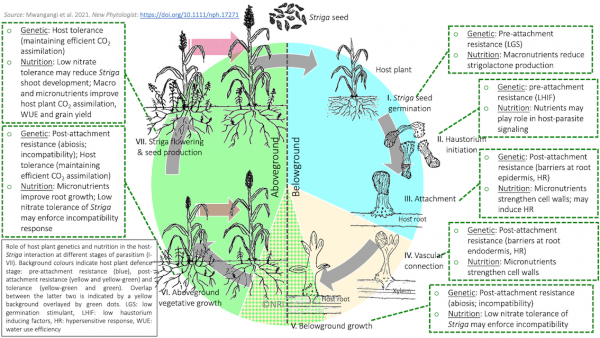Open Access, Research Review, New Phytologist, https://doi.org/10.1111/nph.17271
Authors: Immaculate M. Mwangangi, Lucie Büchi, Stephan M. Haefele, Lammert Bastiaans, Steven Runo & Jonne Rodenburg
In this review paper we explore the potential of improved plant nutrition to fortify the expression of plant inherent resistance and tolerance against Striga in cereals. Beyond reviewing advances in parasitic plant research, we assess relevant insights from phytopathology and plant physiology in the broader sense to identify opportunities and knowledge gaps and to develop the way forward regarding research and development of combining genetics and plant nutrition for the durable control of Striga.
We show that there is limited information on the effects of nutrients on pre-attachment resistance based on a lower production of haustorium inducing factors. In addition, nutrition responses of post-attachment resistance and tolerance are largely unknown. Moreover, most studies have focused on N and P effects on the Striga – host interaction, while overlooking other macro- and micronutrients. While a few functional nutrients have been identified in the salicylic acid pathway underlying the hypersensitive response, further determination of the roles of other macro- and micronutrients to enhance this resistance mechanism would be useful.
Striga tolerance, expressed by host plants that are able to maintain a relatively undisturbed functional equilibrium between shoot and root, can potentially be enhanced by nutrients that strengthen associated traits such as the maintenance of high photosynthesis levels by enhanced stomatal conductance, or the alleviation of drought effects by enhanced water use efficiency or root growth and functioning.
The combination of some nutrients might also have an antagonistic effect, and thereby weaken the host plant defence. Therefore, once effective nutrients for enhanced resistance and tolerance are identified, interaction effects (i.e., synergies and antagonisms) and optimal dosages need to be studied to develop effective compositions of fertilizers.
Next step would then be to identify or develop the most effective delivery technique. Foliar spraying of fertilizers could potentially have a more direct effect on leaf photosynthesis and thereby increase Striga tolerance, but negative effects on the leaves, such as burning, need to be avoided. Also, best spraying timing and technique should be established to prevent concomitant and superfluous fertilization of aboveground Striga plants.
